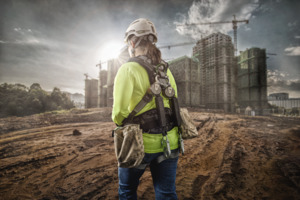
 |
Mark Sennett
Managing Editor |
 |
Kelly Rose
Editor |
| Home> | Slips, Trips & Falls | >Fall Prevention | >High standards |
| Home> | Slips, Trips & Falls | >Fall Protection | >High standards |
High standards
25 February 2025
In 2024,138 fatalities and 600,000 non-fatal accidents were reported from incidents involving work at height (according to the Health & Safety Executive) - figures that have remained similar to those of a decade ago. Despite advancements in technology and safety awareness, the statistics have plateaued, prompting a critical question: how can the industry refocus on safety to drive meaningful change? In this Q&A, Jon Rowan explores potential solutions from a manufacturer’s perspective - focusing on elements such as prioritising safety and advancing the conversation around accident prevention.

What’s your view on the recent statistics around falls while working at height?
It’s interesting to see that the stats have plateaued. On the one hand, it reflects progress - we’ve made significant improvements over the years to reduce falls across Europe. But on the other hand, it shows there’s still work to do. The key areas for improvement seem to be workplace practices, consistent training, and addressing behavioural issues on-site.
However, a big challenge around this is ensuring subcontractors receive the same focus on safety as larger, tier-one construction companies. There’s often a gap in training and resources further down the chain, and that’s where incidents are more likely to happen.
Why do you think the statistics remain as high as they are?
It’s likely because a lot of incidents happen further down the subcontractor chain, where smaller businesses might not have the same resources or emphasis on safety. Larger companies often have dedicated safety professionals and more robust structures in place. Another factor is underreporting - smaller incidents might not always get logged, so safety concerns can go unnoticed until they escalate into something bigger. It’s a tricky area to address, but it’s likely contributing to the plateau in statistics.
What are the general challenges around safety at height?
Education is one of the biggest challenges. Most people understand the basics because most work environments are pretty standard. But when something out of the ordinary comes up, like a unique project or new construction method, gaps in education can become an issue. Frequent and targeted education can help address these challenges and help everyone to be equipped to handle different scenarios safely. Another challenge is complacency - even with the right education, people can fall into routines and overlook potential risks.
How can we shift viewpoints on the importance of safety?
Incentives play a huge role. Larger companies usually have strong incentives to prioritise safety - it’s critical for their reputation and compliance. For smaller businesses, it’s not as clear-cut. Aligning incentives so that everyone, from leadership to workers, sees the value in maintaining high safety standards is key to shifting perspectives.
From a manufacturer’s perspective, how important is training?
We work hard to design products that are intuitive and easy to use, but that only goes so far. Proper training is important because helps to ensure that our products are used correctly and safely. We can develop excellent equipment – but construction companies are responsible for making sure people know how to use it consistently and effectively. I also think training should happen more frequently, especially in fast-paced environments where things can change quickly.
How can manufacturers better educate safety managers, business owners, and contractors?
It’s all about collaboration. Manufacturers can spend time on-site to understand the unique challenges contractors and safety managers face. By working closely with them, we can develop tailored solutions that help to address their specific needs. It’s not just about selling a product - it’s about building a partnership and working together to improve workplace safety. When manufacturers and businesses collaborate, the results are always better.
What stops end-users from wearing PPE?
There are a few common reasons. Sometimes the right gear isn’t available, or it’s damaged and needs replacing. Comfort is another big issue - if PPE is uncomfortable or doesn’t fit well, people are less likely to wear it properly. While adoption of PPE has become more widespread over the years, some people still take a lax approach to using it consistently and correctly. Making PPE more accessible, comfortable, and user-friendly would go a long way in addressing these issues.
How can manufacturers make PPE more appealing to users?
Design plays a huge role. If PPE looks good and has useful features, people are naturally more inclined to wear it. Comfort and functionality are just as important. When PPE is easy to use and fits well, it’s much more likely to be worn correctly. We’ve also found that people are willing to invest in higher-quality PPE when they see the benefits. Offering products that are both stylish and effective can really make a difference in workers’ compliance.
How can we improve safety cultures and make consistent, correct use of PPE feel less like a chore?
It comes down to creating the right incentives. Leaders need to see the value in prioritising safety, not just for compliance but as a core part of their operations. For workers, it’s about making safety feel like a natural part of their job, not an extra burden. When safety practices are aligned with personal and organisational goals, it becomes much easier to build a strong safety culture. Small, consistent reminders and reinforcements can also help - keeping safety top of mind without making it overwhelming.
MSA Safety recently hosted a panel discussion with a range of industry professionals, during which they explored these statistics further and brought together their various experiences to bring new perspectives to an aging issue. Keep an eye on MSA Safety for more information on this industry deep dive.
Jon Rowan is global product group manager for fall protection systems and solutions at MSA Safety. For more information, visit www.msasafety.com
























